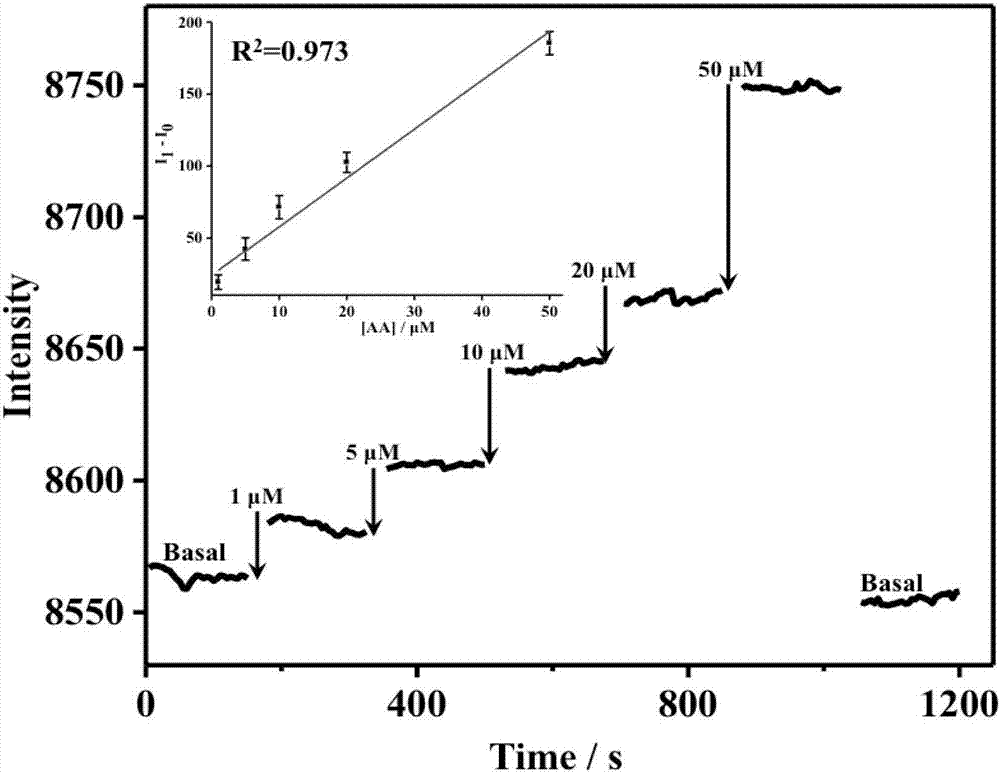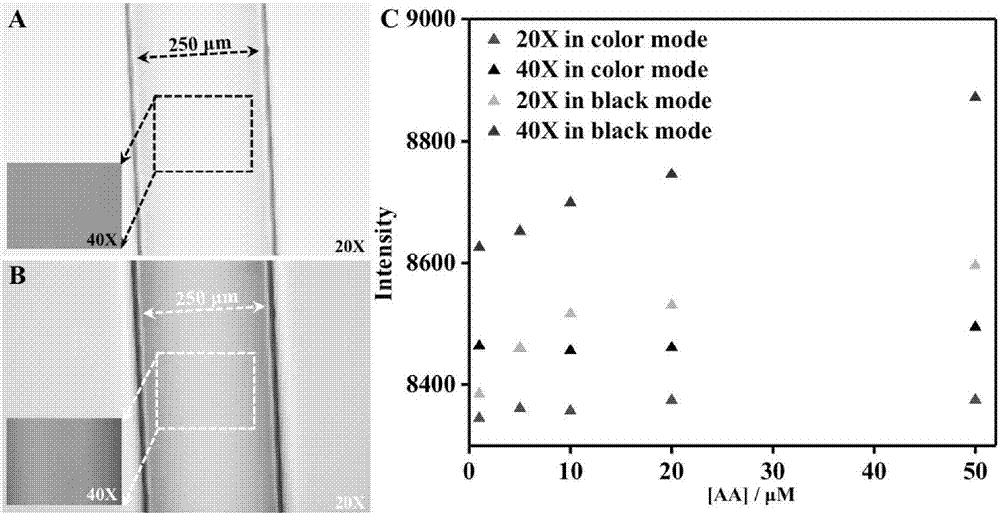Method for sensing and analyzing concentration of ascorbic acid online based on optical microscope and auxiliary color developing agent
A technology of optical microscopy and ascorbic acid, which is applied in the field of nanomaterials and analytical chemistry, can solve problems such as more environmental light requirements, and achieve the effects of easy-to-obtain raw materials, simple preparation, and real-time continuous analysis
- Summary
- Abstract
- Description
- Claims
- Application Information
AI Technical Summary
Problems solved by technology
Method used
Image
Examples
Embodiment 1
[0038] Embodiment 1: the preparation of developer
[0039] (1) Preparation of cobalt oxyhydroxide suspension: first, 10mM CoCl 2 Mix 1mL of the solution with 250μL of 1.0M NaOH solution, and then sonicate for 1 minute; then add 50μL of 0.9M NaClO solution, and then sonicate for 10 minutes, and finally dilute to 40ml to obtain a 40 μg / mL CoOOH suspension for use.
[0040] (2) Preparation of 3,3',5,5'-tetramethylbenzidine solution: Disperse 10 mg of TMB in 1 mL of DMSO, add 1 mL of 0.1 mM CA solution, 20 μL of 0.5 M EDTA solution, and then constant volume to 40mL to obtain a 2mM TMB solution.
[0041] (3) Mix the above TMB solution (2mM) and CoOOH suspension (40μg / mL) in an equal volume ratio, and after mixing thoroughly, the TMB-CoOOH system can be used as a color developer for the detection of ascorbic acid, and placed in the refrigerator spare.
Embodiment 2
[0043] Using the color developer provided in Example 1, ascorbic acid was monitored in an optical online system. Specific steps are as follows:
[0044] (1) The chromogenic agent provided in Example 1 and deionized water are continuously fed into the transparent capillary with an inner diameter of 250nm fixed under the optical microscope at a speed of 3 μL / min, passed through after 15min with an optical microscope (objective lens 40X, Manual magnification 1.6X, black-and-white mode) within 150s, 30 pictures were continuously taken at equal intervals of the transparent capillary, and the light intensity signals of the 30 pictures obtained by continuous pictures were converted into 30 digital signals respectively with the image analysis software ImageJ. Average value, as light intensity value I 0 ;
[0045] (2) After deionized water was passed through for 20 minutes, 5 parts of ascorbic acid standards with concentrations of 1 μM, 5 μM, 10 μM, 20 μM, and 50 μM were sequentially...
experiment example 1
[0051] Experimental Example 1: Effects of Different Shooting Modes on the Sensitivity of Ascorbic Acid Detection
[0052] The color and black and white shooting modes in the microscope will affect the subsequent image recognition effect. Therefore designed the recognition experiment of ascorbic acid under different shooting modes to select optimal shooting mode; Described four kinds of shooting modes are specifically: the color shooting mode under the 20X objective lens, the color shooting mode under the 40X objective lens and the overall manual magnification 1.6X Shooting mode, black and white shooting mode under 20X objective lens, black and white shooting mode under 40X objective lens and overall manual magnification 1.6X. After mixing the chromogenic agent and ascorbic acid of different concentrations in a volume ratio of 10:2 in the centrifuge tube, use a syringe to manually pass the reaction system into the capillary tube, and take pictures under a microscope, wherein th...
PUM
| Property | Measurement | Unit |
|---|---|---|
| Concentration | aaaaa | aaaaa |
| Concentration | aaaaa | aaaaa |
| The inside diameter of | aaaaa | aaaaa |
Abstract
Description
Claims
Application Information
 Login to View More
Login to View More - Generate Ideas
- Intellectual Property
- Life Sciences
- Materials
- Tech Scout
- Unparalleled Data Quality
- Higher Quality Content
- 60% Fewer Hallucinations
Browse by: Latest US Patents, China's latest patents, Technical Efficacy Thesaurus, Application Domain, Technology Topic, Popular Technical Reports.
© 2025 PatSnap. All rights reserved.Legal|Privacy policy|Modern Slavery Act Transparency Statement|Sitemap|About US| Contact US: help@patsnap.com



